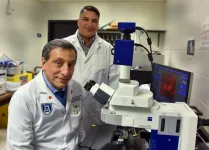"Stroke continues to be a leading cause of death and disability worldwide, with women being more adversely affected by the global burden of stroke," said Stroke Editor-In-Chief Ralph L. Sacco, M.D., M.S., FAHA, a past president of the American Heart Association. "As our population ages, the number of stroke survivors will continue to rise, especially among women. We must include more women in stroke research so we can enhance the critical evidence necessary to provide the appropriate stroke treatments needed to save and improve lives."
Worldwide, stroke is the second leading cause of death. More than 101 million people have a stroke each year, and more than 6.6 million people die of a stroke, annually. About 1 in 4 stroke survivors will experience another stroke within five years.
"The papers highlighted in this issue feature international research and perspective from more than half a dozen countries," said Sacco, chair of the department of neurology, the Olemberg Family Chair in Neurological Disorders and executive director of the Evelyn F. McKnight Brain Institute at the University of Miami Leonard Miller School of Medicine, in Miami, Florida. "This collective work from some of the most renowned scientists in the field offers important insight, recommendations and guidance for addressing this critical topic."
Two of the studies addressed concerns about the lack of women in stroke clinical trials, thus limiting information to ensure appropriate stroke treatment for women, which has long been an issue for scientists.
Why Are Women Less Represented in Intracerebral Hemorrhage Trials? - Tatiana Greige et al. Researchers examined the different reasons men and women were excluded from a major trial about treatment for hemorrhagic, or bleeding, strokes.
The intracerebral hemorrhage DEFeroxamine (iDEF) trial was a prospective, multicenter, randomized, placebo-controlled, double-blind, phase 2 trial that evaluated the use of deferoxamine mesylate versus placebo (saline) infusions in patients with hemorrhagic strokes at 40 hospitals in Canada and the U.S. While iDEF included 293 participants, only 38.2% of participants were women. The major reason for this disparity was the exclusion of participants over the age of 80 -- 22.4% of women were not included in the trial for this reason versus 12.61% of men.
The under-enrollment of women in stroke clinical trials: What are the causes and what should be done about it? - Cheryl Carcel; Matthew Reeves
Addressing the age barrier to stroke research is one of several recommendations offered in a commentary of presentations made at the European Stroke Organization-World Stroke Organization 2020 virtual conference. The authors noted that discrepancies in the enrollment of women in stroke clinical trials raises concerns about the generalizability of trial results, as well as the potential for reduced access and use of new therapies in women. Their recommendations for addressing this include:
More research, both quantitative and qualitative, should be undertaken to identify the causes and barriers to enrolling women in stroke clinical trials, particularly to understand how the attitudes and beliefs of women towards research and health in general may be impacting their participation in studies. Stroke trials should avoid using an upper age limit as an exclusion criterion (e.g., >80 years) since this has been shown to have a disproportionate effect on the number of women enrolled in trials. Researchers should make greater efforts to collect appropriate data from trial screening logs to better identify specific factors that could help in understanding why women may be under-enrolled in stroke trials. The number of trial investigators and research staff who are women should be increased and has the potential to create environments in which more women are enrolled in stroke clinical trials. Below are highlights of some of the other manuscripts in this issue, which can be accessed in full here.
Sex, age, and socioeconomic differences in non-fatal stroke incidence and subsequent major adverse outcomes - Ralph K. Akyea et al.
Researchers for this large cohort study used data from the Clinical Practice Research Datalink (CPRD) and Hospital Episode Statistics (HES) to assess stroke incidence in the general population of the United Kingdom from 1998-2019. During this time, 82,774 people survived a stroke, of which 44,614 (53.9%) were women. Men in the study experienced stroke at a younger age compared to women (71.4 vs 76.9 years, respectively). Men ages 30-74 years had higher stroke incidence rates compared to women; however, among those ages 75 and older, the incidence rates were much higher in women.
The rate of stroke incidence among people ranked in the lowest ranking of socioeconomic status was 10% higher than the rate in the highest socioeconomic status rank. Those rankings were based on such factors as income; employment; education, skills and training; health and disability; crime; barriers to housing and services; and living environment.
The researchers also examined a subset of 68,877 stroke survivors who had not had previous complications. Of those:
47,500 eventually had a major adverse cardiovascular event, 25,731 were women (68.8% of all the female survivors); 33,831 had another stroke (more than 52% were women); 20,335 died of any cause (more than 59% were women); and 9,174 died of cardiovascular complications (more than 61% were women). The researchers noted their findings show a higher burden of major adverse outcomes (such as a cardiovascular event, stroke or death) observed in women when compared to men after first non-fatal stroke is largely accounted for by age and socioeconomic status.
Advances in Stroke: Stroke in Women - Moira K. Kapral et al.
This paper highlights recent advances in the understanding of sex differences in the benefits of endovascular therapy, outcomes after stroke and the potential to prevent stroke in women with a history of hypertensive disorders of pregnancy. This perspective paper includes data analysis from several clinical trials. The researchers found:
The relatively new treatment of mechanical removal of a blood clot, known as endovascular therapy (EVT), was associated with similar functional independence in women and men. Additionally, women had a nearly two-year gain in disability-adjusted life years after EVT compared to men, and women and men had similar 90-day mortality, functional independence, safety outcomes and successful restoration of blood flow to the brain. The researchers noted that while many clinical trials of EVT tended to exclude older women with pre-stroke disability and comorbid conditions, the results of their analysis point to this treatment being equally beneficial for men and women. The authors identified numerous instances of women having worse stroke outcomes than men - and women had higher rates of death, disability and quality of life, much of which can be attributed to age, stroke severity, pre-stroke function capacity and depression. They suggest targets for interventions could include efforts to reduce stroke severity (e.g., through management of stroke risk factors), address mood disorders (e.g., through routine screening and treatment) and optimize functional status and quality of life (e.g., through rehabilitation). Another analysis found women are less likely than men (67.8% vs. 76.8%) to be diagnosed with stroke or cerebrovascular event, and there is less investigation into the causes of stroke among women. The authors noted these results are consistent with previous research, and the lack of cause identification and the management of vascular risk factors could have dangerous consequences. The researchers also analyzed findings from the California Teachers Study that found the risk of stroke before age 60 was modified by aspirin use in women with hypertensive disorders of pregnancy. Women who did not use aspirin had an increased risk of stroke, while those on aspirin therapy did not. The authors noted the fact that aspirin can prevent preeclampsia when taken during pregnancy suggests an interesting link for aspirin use, hypertensive disorders of pregnancy and ischemic stroke risk beyond child-bearing years. These findings are also consistent with prior studies that have identified hypertensive disorders of pregnancy as a risk factor for subsequent stroke, and the authors suggest that aspirin could be a target for future controlled trials for stroke prevention. The other studies in this special issue include:
The female stroke - sex differences in acute treatment and early outcomes of acute ischemic stroke - Anna Bonkhoff et al. Absence of consistent sex differences in outcomes from symptomatic carotid endarterectomy and stenting trials - Virginia Howard et al. Influence of pregnancy on hemorrhage risk in women with cerebral and spinal cavernous malformations - Nycole Joseph et al. Sex-related differences in clinical features, neuroimaging and long-term prognosis after transient ischemic attack - Francisco Purroy et al. Stroke incidence by sex across the lifespan - Manav Vyas et al. Authors' disclosures and funding sources for all studies in the special issue are listed in the individual manuscripts.
"We are pleased to publish this important research to enhance our understanding of the unique differences in the diagnosis, treatment and prevention of stroke in women," Sacco said. "Our essential goal is to prevent stroke, reduce disability and ultimately save lives; education and awareness are critical first steps."
To raise awareness about how participation in research could further scientific understanding of cardiovascular health, the American Heart Association and Verily, Alphabet's life sciences and healthcare arm, have launched Research Goes Red. Research Goes Red aims to empower women to contribute to health research. Learn more at www.goredforwomen.org/en/get-involved/research/research-goes-red
INFORMATION:
Additional Resources:
Multimedia is available on the right column of the release link: https://newsroom.heart.org/news/despite-some-advances-women-still-face-disparities-of-the-global-burden-of-stroke?preview=b1c967bbda5e906a27b51f9c073e7d6a
After Jan. 25, view the manuscripts online.
More work needed to ensure women are represented in research trials
Heart Attack and Stroke Symptoms in Women
Follow AHA/ASA news on Twitter @HeartNews
Follow news from Stroke, the ASA/AHA journal @StrokeAHA_ASA
Statements and conclusions of studies published in the American Heart Association's scientific journals are solely those of the study authors and do not necessarily reflect the Association's policy or position. The Association makes no representation or guarantee as to their accuracy or reliability. The Association receives funding primarily from individuals; foundations and corporations (including pharmaceutical, device manufacturers and other companies) also make donations and fund specific Association programs and events. The Association has strict policies to prevent these relationships from influencing the science content. Revenues from pharmaceutical and biotech companies, device manufacturers and health insurance providers are available here, and the Association's overall financial information is available here.
About the American Stroke Association
The American Stroke Association is a relentless force for a world with fewer strokes and longer, healthier lives. We team with millions of volunteers and donors to ensure equitable health and stroke care in all communities. We work to prevent, treat and beat stroke by funding innovative research, fighting for the public's health, and providing lifesaving resources. The Dallas-based association was created in 1998 as a division of the American Heart Association. To learn more or to get involved, call 1-888-4STROKE or visit stroke.org. Follow us on Facebook and Twitter.



